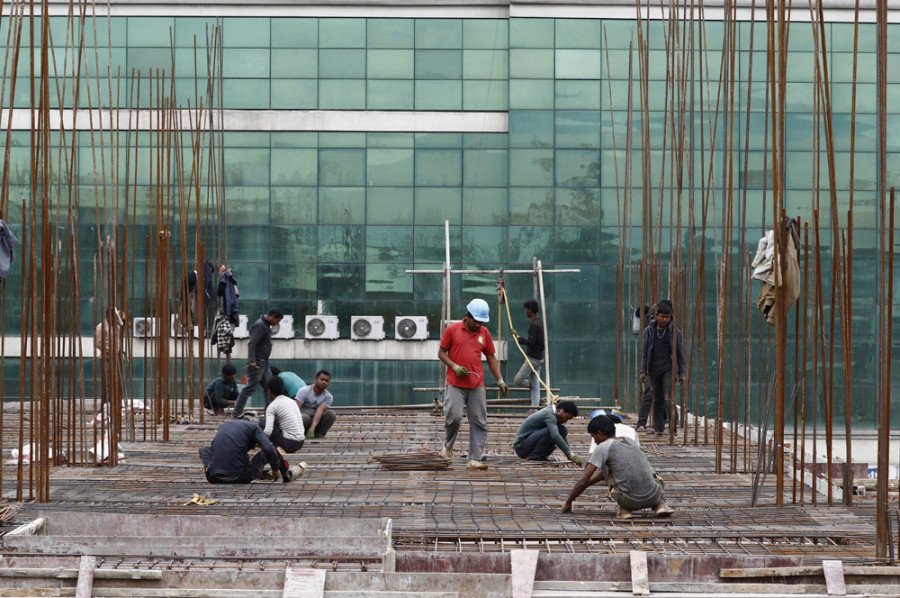Money
Nepal’s economic growth tapers off as construction slackens and remittances slow in the first quarter
The country’s GDP is likely to grow at 7 percent this fiscal year, lower than the government’s 8.5 percent target, experts say.
Prithvi Man Shrestha
Bikas Maharjan has been wondering what will happen to his business if the demand for bricks continues to fall. For years, he sold as many as 50,000 bricks a day, but in recent months, that number has fallen to 20,000 units.
“Since late summer, there’s been a sharp decline in the demand for bricks from Kathmandu Valley,” says Maharjan, who owns Hira Bricks, a brick manufacturing company.
A slump in the demand for bricks suggests that the construction sector is slowing down in the Valley, an assumption supported by a slowdown in housing loans in recent months. Construction is considered a key indicator of the health of the economy as it shows consumption patterns.
According to Nepal Rastra Bank, credit for residential construction increased by 4.1 percent during the first three months of the current fiscal year, compared to 8.7 percent during the same period last fiscal year.
Credit growth in the non-residential sector grew a mere 0.3 percent compared to a 3.3 percent growth in the corresponding period a year earlier. Credit growth in financing highways and bridges also decreased to 7.7 percent from 12.8 percent.
There has also been sluggishness in the demand for iron, steel and cement, according to industrialists. Despite the country becoming more or less self-reliant on cement, the demand has not been growing as anticipated, they say.
“The demand for cement has remained stable,” said Dhruba Thapa, president of the Cement Manufacturers’ Association, an umbrella body of cement manufacturers. “I see this as a seasonal effect of the construction slowdown, particularly during the monsoon. But the issues that concern us are the government’s continued low capital spending and sluggish demand for cement in the domestic market despite almost zero imports.”
During the first three months of the current fiscal year, Nepal imported cement worth Rs199 million, a 13 percent decline over the same period last fiscal year. In the same quarter, imports of iron and steel decreased 22.5 percent to Rs34.24 billion compared to the same period a year ago, according to the Trade and Export Promotion Centre.
“As no new project has been initiated in the areas of iron, steel, and cement this year, lending in the sector has also not gone up as expected,” said Gyanendra Dhungana, president of Nepal Bankers’ Association, a group of banking chief executive officers.
Industrialists and economists say the sluggish demand for construction materials and the tepid growth in lending suggest an overall slackness in the economy.
“We can say that the economy is not performing well at the moment,” said Shekhar Golchha, senior vice-president of the Federation of Nepalese Chambers of Commerce and Industry, the apex private sector body. “The government’s failure to spend the capital budget which creates demand for construction materials and a lack of adequate liquidity in the banking sector are creating hurdles in the investment decisions of the private sector.”
According to Golchha, government expenditure plays the role of a catalyst in spurring private sector investments. As of November 24, the government’s capital expenditure stood at just 6.6 percent, according to the Financial Comptroller General Office, which keeps records of income and expenditure of the government.
Golchha said that the investment climate in Nepal has deteriorated despite the World Bank in its Doing Business Report that said there has been an improvement.
Experts say limited post-earthquake reconstruction activities this year, compared to the past two years, may have impacted the overall demand for construction materials this year. The National Reconstruction Authority said last week that 62 percent of quake-damaged houses have been rebuilt and 24 percent of them are under reconstruction. With the country witnessing a slowdown in construction activities, there has been a drop in demand for consumer items too, according to businessmen.
Automobile dealers also say they are seeing a decrease in demand for vehicles, particularly due to the government’s unfriendly policy towards vehicle imports. As per a central bank’s directive, a person keen on purchasing a vehicle should first make a down payment of 50 percent to be eligible to get bank loans. In the past, a buyer could get loans up to 90 percent of the vehicle price. According to the central bank, the import of vehicles and their parts decreased by 18 percent during the first three months of this fiscal year.
“The government’s policy of discouraging vehicle imports and decreasing remittances from overseas have contributed to the decline in vehicle sales,” said Sunil Rijal, general secretary of NADA Automobiles Association of Nepal, a grouping of vehicle importers. During the first three months, remittance inflows decreased by 4.9 percent to Rs230 billion.
Economists say that if the remittance inflows continue to go down, it will have a major impact on the overall consumption in the country, which would hit the economy hard.
“It is the main driver for economic activities in the country and the continuation of the decline in remittances could severely affect the growth prospects,” said Shankar Sharma, former vice-chairman of the National Planning Commission.
Slowing demand, as well as the government’s effort to control imports, has contributed to a less than expected growth in revenue collections. The government suffered a revenue shortfall of Rs70 billion, 28 percent below the target, in the first quarter of the current fiscal year, according to the Finance Ministry.
The federal government has set an economic growth target of 8.5 percent for the current fiscal year.
“Anticipating that manufacturing and services sectors will pick up steam in the coming months, I think the country’s economy will grow by around seven percent,” the central bank official added.
The World Bank has already projected economic growth to slow down to 6.4 percent in the current fiscal year.
“The ministry is studying the possibility of an increase in capital expenditure to spur the economy,” said Yagya Dhugel, joint-secretary at the Finance Ministry. “We’ve also asked the central bank to study the impact of decreasing imports and remittances.”




 18.12°C Kathmandu
18.12°C Kathmandu














